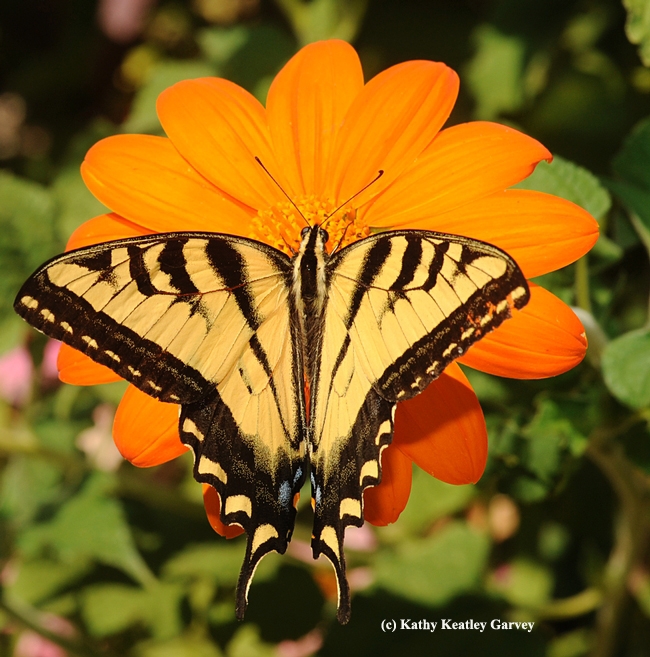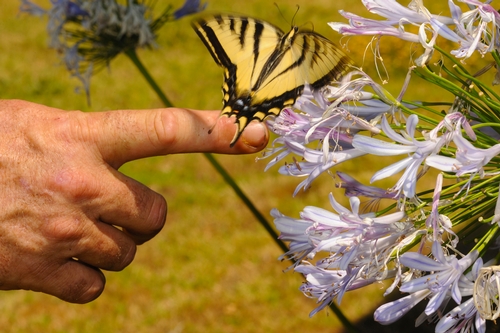- Author: Kathy Keatley Garvey
Don't look now, but a garden spider almost grabbed a tiger by the tail.
The tiger? That would be the Western tiger swallowtail, Papilio rutulus.
The ragged wings of the butterfly (below) show signs of a close encounter with a predator--maybe another spider, a praying mantis or a bird.
The Western tiger swallowtails are drop-dead gorgeous. Sporting a yellow-and-black wingspan of 2.75 to 4 inches (when not tattered by a predator!), these butterflies attract attention as they glide around gardens and parks and in riparian forests.
This is one of the butterflies that distinguished scientist Arthur Shapiro, professor of evolution and ecology at UC Davis studies. Check out his amazing butterfly website.
LiveScience, in partnership with the National Science Foundation, recently showcased him in a feature story, "Passion for Butterflies Becomes a Study in Climate Change Impact."
You'll want to read how Shapiro first became involved in the wonderful world of butterflies, and how that passion led to a massive butterfly data collection he launched more than 40 years ago.
Despite "the high altitudes, rigorous walks and over cooperative weather, he's still going strong, exploring mountains across central California, pen and notebook in hand," wrote Ayesha Monga Kravtz of the National Science Foundation.
"Through phylogeography, Shapiro is trying to reconstruct the history of the high-mountain butterfly faunas both on the West coast of North America and in the southern parts of South America, such as Argentina and Chile," Kravtz wrote. "By reconstructing the history of these faunas, where they came from, how they moved and when, scientists and researchers can make predictions as to how the fauna will respond to climate change in the future."
And, as Shapiro told Kravtz: "The past is the key to the future."
Indeed it is. And that would include the comings and goings of the Western tiger swallowtail.


- Author: Kathy Keatley Garvey
Sometimes you can't get within 20 feet of a Western tiger swallowtail butterfly (Papillo rutulus).
Sometimes it's a matter of inches.
That was the case this morning at the Häagen-Dazs Honey Bee Haven at the University of California, Davis, when a lone Western tiger swallowtail took a liking to the Mexican sunflowers (Tithonia rotundifolia).
The spectacular butterfly, one of the most recognizable of all butterflies, glided to the patch of Mexican sunflowers (so named because they originate from Mexico and Central America) sipped a little nectar, and then fluttered away, only to return again.
Not once, but dozens of times.
The haven, a half-acre bee friendly demonstration garden planted next to the Harry H. Laidlaw Jr. Honey Bee Research Facility on Bee Biology Road, west of the main campus, features ornamentals, vegetables, fruits and nuts (almonds), as well as art work from the UC Davis Art/Science Fusion Program. It's open from dawn to dusk; admission is free.
The Mexican sunflowers, family Asteraceae, grow a towering eight feet, and are as orange as the jerseys of the San Francisco Giants. Today they attracted scores of honey bees, sunflower bees, hover flies, sweat bees, and yes, a spotted cucumber beetle (pest).
However, the "tiger" in the Tithonia stole the show.


- Author: Kathy Keatley Garvey
Tame that tiger.
Wilton beekeeper Brian Fishback, president of the Sacramento Area Beekeepers' Association, stopped Friday at the Harry H. Laidlaw Jr. Honey Bee Research Facility, UC Davis, and a friendly Western tiger swallowtail greeted him.
At least, it seemed quite friendly.
Fishback and Laidlaw staff research associate Elizabeth “Liz” Frost paused to watch the butterfly (Papilio rutulus) glide in and out of the flower garden in front of the facility.
Fishback held out his hand. The butterfly obliged and touched down for just a moment.
This year is a good year for Western tiger swallowtails.
There’s an outbreak--or an elevated population--in the area, says noted butterfly expert Arthur Shapiro, professor of evolution and ecology at UC Davis. “I’ve seen as many as 11 a day in Davis recently, and the outbreak ranges from as far west as Vallejo and as far east as Reno.”
This is the second year for elevated populations of the tiger, Shapiro says. The epicenter seems to be Davis.
The colorful butterfly visits a variety of hosts, including California yerba santa, milkweed, lilies, lilacs, coyote mint, California buckeye, sycamore, privet and sweet gum.It doesn't mind being around the 6 million honey bees (from 110 hives) in the apiary at the Laidlaw facility, either.



- Author: Kathy Keatley Garvey
Oo-laa! Ookow!
What a treat to see the Western Tiger Swallowtail (Papilio rutullus) gliding into a patch of ookow (Dichelostemma congestum), also known as wild hyacinth.
A recent outing to Healdsburg, Sonoma County, found the tiger on the ookow.
The colors were perfect: the bright yellow butterfly bordered in black visiting the delicate purple flower with light yellow stamens.
Fortunately, the Western Tiger Swallowtail cooperated with the photographer by lingering in the flowers. He perched, wings open, then fluttered away.
Him? Yes. UC Davis butterfly expert Art Shapiro knows his butterflies.
He also knows his "hims" and "hers."


- Author: Kathy Keatley Garvey
Talk about a tiger by the tail.
That would be the Western Tiger Swallowtail (Papilio rutulus).
It's returned to the Davis area after a 15-year hiatus.
Butterfly expert Arthur Shapiro, professor of evolution and ecology at the University of California, Davis, says the Western Tiger, one of the largest and showiest of butterflies, “was relatively common in Davis until the early 1990s, when it suddenly disappeared.”
"Since then there have been no sightings at all--or at most one or two per year--until this year. Now it looks like it's back as if nothing had happened!"
Since March 26, Shapiro has tallied about 100 sightings in the Davis/Vacaville area. "It's still flying today," he says.
The butterfly, with a wingspan of three to four inches, has bright yellow wings edged with a black border. Four diagonal stripes grace the top of the wings, and blue and orange spots on the hind wings, near its tail. Its normal range covers much of western North America, from British Columbia to North Dakota in the north to Baja California and New Mexico in the south. It nectars from many flowers including thistles, abelia, California buckeye, zinnia, and yerba santa.
Florian Altermatt, a visitor from Switzerland, spotted the first Western Tiger March 26 near the Memorial Union, UC Davis campus. He had no idea the species had "disappeared.”
Shapiro saw the next one on April 12. Between then and June 4, six more sightings occurred: on campus, in central Davis, and in both east and west Davis.
“The second generation was first spotted on campus on June 24 and in the next five days there were eight more sightings--on campus and in central Davis,” Shapiro said. “There's no doubt the Western Tiger is breeding here again. The mystery is why it ever went away."
Naturalist/photographer Greg Kareofelas has seen the Western Tiger in Davis “consistently” since the last week in June. “It’s an incredible phenomenon,” he said. “I have lived in Davis since 1972 and this is the most I have ever seen. In the last 18 years of ‘Davis record keeping,’ I’ve been averaging about one Davis sighting a year. This year, I have been seeing about one a day for the last seven weeks. My data is only for my yard in east Davis. So this year is unparalleled.”
And Vacaville? "They are just as common in Vacaville as they are here in Davis this year,” he said. “In Vacaville, they never went away.”
“I set a site-specific day record for me with 22 at Gates Canyon (Vacaville) on July 7, and another with eight in the Suisun Marsh on Aug. 9,” Shapiro said.
Lynn Kimsey, director of the Bohart Museum of Entomology, and professor and vice chair of the UC Davis Department of Entomology, said the Bohart Museum “has a large collection of these butterflies, in part due to the efforts of Art Shapiro and his students. The collection is important because it archives where the swallowtails have been found in the past, and changes in their distribution over time.”
Shapiro, author of the 359-page Field Guide to Butterflies of the San Francisco Bay and Sacramento Valley Regions, maintains a Web site covering more than three decades of collected data.
So, if you see the Western Tiger in the Davis area, e-mail Shapiro at amshapiro@ucdavis.edu.
He's glad "the tiger" is back.




